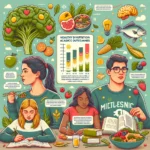As an experienced IELTS instructor, I understand the importance of staying updated with current topics that frequently appear in the reading section. One such topic that has gained significant traction in recent years is “The Effects of Technology on Reading Habits.” This subject has appeared in various forms across multiple IELTS tests, making it a crucial area for candidates to focus on.
The reading section of IELTS requires candidates to demonstrate their ability to understand complex texts, identify key information, and analyze the author’s viewpoint. With the increasing prevalence of technology in our daily lives, its impact on reading habits has become a popular subject for examination. Based on trends observed in past IELTS tests and the ongoing relevance of this topic, it’s highly likely that similar passages will continue to appear in future exams.
Let’s dive into a practice reading passage on this subject, followed by a set of questions that mirror the style and difficulty level you can expect in the actual IELTS test.
 Digital devices affecting reading habits
Digital devices affecting reading habits
Practice Reading Passage
The Digital Revolution and Its Impact on Reading
A. The advent of digital technology has revolutionized the way we consume information, and reading habits are no exception. With the proliferation of e-readers, tablets, and smartphones, people now have access to vast libraries of digital content at their fingertips. This shift has led to significant changes in how, when, and what we read.
B. One of the most noticeable effects of technology on reading habits is the increase in screen time. According to a study by the Pew Research Center, the percentage of Americans who read e-books has risen from 17% in 2011 to 28% in 2021. This trend is particularly pronounced among younger generations, who have grown up with digital devices as a constant presence in their lives.
C. The convenience of digital reading has its advantages. E-books are often cheaper than their print counterparts, take up less physical space, and can be accessed instantly. Many e-readers also offer features like adjustable font sizes, built-in dictionaries, and the ability to highlight and make notes, enhancing the reading experience for some users.
D. However, the shift towards digital reading has not been without its drawbacks. Some studies suggest that reading on screens may lead to decreased comprehension and retention compared to reading printed text. The phenomenon known as “screen fatigue” can cause eye strain and headaches, potentially discouraging prolonged reading sessions.
E. Moreover, the constant connectivity of digital devices can be a double-edged sword. While it allows for easy access to a wealth of information, it also introduces numerous distractions. Social media notifications, emails, and the temptation to multitask can interrupt the flow of reading and reduce overall concentration.
F. The impact of technology on reading habits extends beyond the format of the text itself. The internet has given rise to new forms of content consumption, such as blog posts, social media updates, and news feeds. These bite-sized pieces of information cater to shorter attention spans and may be changing the way people process and engage with longer-form content.
G. Despite these challenges, it’s important to note that technology has also opened up new opportunities for reading. Digital platforms have made it easier for aspiring authors to self-publish, leading to a more diverse range of voices and perspectives in literature. Additionally, features like text-to-speech and audiobooks have made reading more accessible to those with visual impairments or learning disabilities.
H. As we navigate this digital landscape, it’s clear that reading habits will continue to evolve. The key lies in finding a balance between embracing the benefits of technology and maintaining the deep, focused reading that has been the cornerstone of learning and personal growth for centuries.
Questions
True/False/Not Given
Do the following statements agree with the information given in the reading passage? Write
TRUE if the statement agrees with the information
FALSE if the statement contradicts the information
NOT GIVEN if there is no information on this
- The percentage of Americans reading e-books has increased over the past decade.
- E-books are always cheaper than printed books.
- Reading on screens has been proven to improve comprehension compared to reading printed text.
- Digital devices have made reading more accessible for people with certain disabilities.
- The majority of young people prefer reading printed books to e-books.
Multiple Choice
Choose the correct letter, A, B, C, or D.
-
According to the passage, which of the following is NOT mentioned as an advantage of e-books?
A) They are more portable than physical books.
B) They often cost less than printed books.
C) They allow for easy adjustment of font size.
D) They have a longer shelf life than printed books. -
The term “screen fatigue” refers to:
A) A decrease in the popularity of e-readers
B) Physical discomfort caused by prolonged screen use
C) The tendency to read less on digital devices over time
D) The difficulty in focusing on digital text
Matching Headings
Match the following headings to the correct paragraphs in the passage. Write the correct letter, A-H, next to the numbers 8-11 below.
List of Headings:
I. The rise of digital reading
II. Balancing technology and traditional reading
III. New opportunities in digital publishing
IV. The problem of distractions in digital reading
V. Comparing comprehension levels
VI. The evolution of content consumption
VII. Accessibility improvements through technology
VIII. The convenience of e-books
- Paragraph C
- Paragraph E
- Paragraph F
- Paragraph G
Summary Completion
Complete the summary below using words from the box.
convenient challenging comprehension diverse distracting expensive
The impact of technology on reading habits has been both positive and negative. While digital reading offers a more (12) __ experience with features like adjustable fonts and instant access, it also presents some (13) __ aspects. Studies suggest that screen reading may negatively affect (14) __ and retention. Additionally, the constant connectivity of digital devices can be (15) __, interrupting the reading process. However, technology has also made reading more accessible and allowed for a more (16) __ range of published voices.
Answer Key and Explanations
-
TRUE
Explanation: Paragraph B states that “the percentage of Americans who read e-books has risen from 17% in 2011 to 28% in 2021.” -
FALSE
Explanation: Paragraph C mentions that “E-books are often cheaper than their print counterparts,” not always cheaper. -
FALSE
Explanation: Paragraph D states that “Some studies suggest that reading on screens may lead to decreased comprehension and retention compared to reading printed text.” -
TRUE
Explanation: Paragraph G mentions that “features like text-to-speech and audiobooks have made reading more accessible to those with visual impairments or learning disabilities.” -
NOT GIVEN
Explanation: The passage does not provide information comparing young people’s preferences for e-books versus printed books. -
D
Explanation: The passage does not mention anything about the shelf life of e-books compared to printed books. Options A, B, and C are all mentioned as advantages in Paragraph C. -
B
Explanation: Paragraph D describes “screen fatigue” as a phenomenon that “can cause eye strain and headaches,” which aligns with option B. -
VIII
Explanation: Paragraph C discusses the convenience of e-books, mentioning their lower cost, space-saving nature, and instant accessibility. -
IV
Explanation: Paragraph E focuses on how the connectivity of digital devices can be distracting during reading. -
VI
Explanation: Paragraph F discusses how technology has led to new forms of content consumption, such as blog posts and social media updates. -
III
Explanation: Paragraph G mentions how digital platforms have made it easier for aspiring authors to self-publish, leading to more diverse voices in literature. -
convenient
-
challenging
-
comprehension
-
distracting
-
diverse
Common Mistakes to Avoid
-
Overlooking specific details: In questions like True/False/Not Given, pay close attention to qualifiers such as “often,” “always,” or “some.” These can change the meaning of a statement significantly.
-
Making assumptions: Stick to the information provided in the passage. For example, while the text mentions increased e-book usage among younger generations, it doesn’t state their preference over printed books.
-
Misinterpreting complex sentences: Practice breaking down longer sentences to understand their core meaning. This is particularly important in passages discussing scientific studies or statistics.
-
Rushing through the passage: Take time to understand the main idea of each paragraph. This will help you answer questions like matching headings more accurately.
-
Ignoring context: When completing summaries or sentence completion questions, make sure your answers fit grammatically and contextually within the sentence.
Vocabulary Focus
- Proliferation (noun): rapid increase in the number or amount of something
- Pronounced (adjective): very noticeable or marked
- Retention (noun): the ability to keep or continue having something
- Double-edged sword (idiom): something that has both positive and negative effects
- Multitask (verb): to do several things at the same time
- Bite-sized (adjective): small and easy to deal with or understand
- Aspiring (adjective): hoping to be successful in a particular career
Grammar Spotlight
Pay attention to the use of present perfect tense in the passage, such as in the sentence: “The percentage of Americans who read e-books has risen from 17% in 2011 to 28% in 2021.” This tense is used to describe actions that started in the past and continue to the present or have present relevance.
Tips for High Scores in IELTS Reading
-
Time management: Practice completing reading tasks within the allotted time. Allocate about 20 minutes for each passage in the actual test.
-
Skim and scan: Quickly skim the passage for main ideas, then scan for specific details when answering questions.
-
Read the questions first: This can help you focus on relevant information while reading the passage.
-
Utilize paragraph headings: These can give you a quick overview of the passage structure and main topics.
-
Practice regularly: Familiarize yourself with different question types and develop strategies for each.
-
Expand your vocabulary: Read widely on various topics to build your academic vocabulary.
-
Don’t leave blanks: Even if you’re unsure, make an educated guess. There’s no penalty for incorrect answers.
Remember, success in IELTS Reading comes with consistent practice and developing effective reading strategies. Focus on understanding the overall message of the passage while being able to locate specific details quickly. By mastering these skills, you’ll be well-prepared to tackle any topic that appears in your IELTS Reading test, including complex subjects like the effects of technology on reading habits.
For more practice on related topics, you might find our articles on the effects of technology on sleep patterns and social media’s impact on personal relationships helpful in broadening your understanding of technology’s influence on various aspects of modern life.


